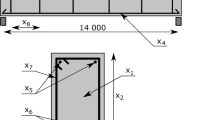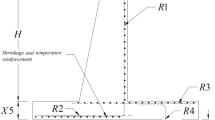Abstract
Optimization of structural members such as beams and columns has received increasing interest with advances in computing, manufacturing, and artificial intelligence. Designers pursuing multiobjective optimization are typically interested in minimizing the cost of the member while maximizing some performance metric related to load bearing capability or stress. In this study, thin-walled members listed in AISC tables were optimized in a similar manner using genetic algorithms. The influence of several objectives was considered, and emphasis was placed on providing the customer with a diverse choice of solutions. To demonstrate the approach, wide-flange I-beams and circular pipe cross-sections were examined. Multi-dimensional Pareto-fronts were obtained. Optimized cross-sections were compared to AISC beam tables. Multi-criteria decision-making techniques were used to select a preferred solution from a Pareto-front. For I-beams, improvements of 3–7% over tables were obtained and for pipes, it was 47–76%. Finally, the performance of two commonly used genetic algorithms, NSGA-II and SPEA-II, was compared using Pareto-front metrics. While SPEA-II produced several nondominated solutions, NSGA-II was shown to produce the overall superior front considering metrics presented from the literature.














Similar content being viewed by others
References
Audet C, Bigeon J, Cartier D, Le Digabel S, Salomon L (2018) Performance indicators in multiobjective optimization. Eur J Oper Res (preprint submitted)
Branke J, Deb K, Dierolf H, Osswald M (2004) Finding knees in multi-objective optimization. In: Yao X et al (eds) Parallel problem solving from nature, PPSN, LNCS 3242. Springer, Heidelberg, pp 722–731
Chakraborty D, Vaz W, Nandi AK (2015) Optimal driving during electric vehicle acceleration using evolutionary algorithms. Appl Soft Comput 34:217–235
De Munck M, De Sutter S, Verbruggen S, Tysmans T, Coelho RJ (2015) Multi-objective weight and cost optimization of hybrid composite-concrete beams. Compos Struct 134:369–377
Deb K, Pratap A, Agarwal S, Meyarivan T (2002) A fast elitist non-dominated sortinggenetic algorithm for multi-objective optimisation: NSGA-II. IEEE Trans Evol Comput 6(2):182–197
El-Rayes K, Hyari K (2005) Optimal lighting arrangements for nighttime highway construction projects. J Constr Eng Manag 131(12):1292–1300. https://doi.org/10.1061/(ASCE)0733-9364(2005)131:12(1292)
Global Alliance for Buildings and Construction, International Energy Agency, United Nations Environment Programme (2019) 2019 Global status report for buildings and construction: towards a zero-emission, efficient and resilient buildings and construction sector. UNEP, Paris, France
He M-X, Sun J-Q (2018) Multi-objective structural-acoustic optimization of beams made of functionally graded materials. Compos Struct 185:221–228
Loorits K (1995) Classification of cross section for steel beams in different design codes. Rakenteiden Mekaniikka 28(1):19–33
Mayencourt P, Mueller C (2020) Hybrid analytical and computational optimization methodology for structural shaping: material-efficient mass timber beams. Eng Struct 215:110532
Miettinen K (1998) Interactive methods. Nonlinear multiobjective optimization. Springer, Boston, pp 131–213
Nguyen XH, Bui LT, Tran CT (2019) Improving many objective optimisation algorithms using objective dimensionality reduction. Intel, Evol. https://doi.org/10.1007/s12065-019-00297-4
Ostwald M, Rodak M (2013) Multicriteria optimization of cold-formed thin-walled beams with generalized open shape under different loads. Thin-Walled Struct 65:26–33
Ozbasaran H, Yilmaz T (2018) Shape optimization of tapered I-beams with lateral-torsional buckling, deflection and stress constraints. J Constr Steel Res 143:119–130
Parastesh H, Hajirasouliha I, Taji H, Sabbagh AB (2019) Shape optimization of cold-formed steel beam-columns with practical and manufacturing constraints. J Constr Steel Res 155:249–259
Pörtner H-O, Roberts DC, Masson-Delmotte V, Zhai P, Tignor M, Poloczanska E, Mintenbeck K, Alegría A, Nicolai M, Okem A, Petzold J, Rama B, Weyer NM (2019) IPCC special report on the ocean and cryosphere in a changing climate. IPCC, Geneva (in press)
Stadler W (1986) Multicriteria optimization in mechanics—a survey. Appl Mech Rev 37(2):277–286
Suresh S, Sujit PB, Rao AK (2007) Particle swarm optimization approach for multi-objective composite box-beam design. Compos Struct 81:598–605
Swain FG et al (1923) American institute of steel construction for the design, fabrication, and erection of structural steel for buildings. AISC, Chicago
United Nations (2019) Growing at a slower pace, world population is expected to reach 9.7 billion in 2050 and could peak at nearly 11 billion around 2100. Department of Economic and Social Affairs, https://www.un.org/development/desa/en/news/population/world-population-prospects-2019.html. Accessed 18 May 2020
Vo-Duy T et al (2017) Multi-objective optimization of laminated composite beam structures using NSGA-II algorithm. Compos Struct 168:498–509
Zadeh L (1963) Optimality and non-scalar-valued performance criteria. IEEE Trans Autom Control 8(1):59–60
Zitzler E, Laumanns M, Thiele L (2001) SPEA 2: improving the strength Pareto evolutionary algorithm. Technical Report 103, Computer Engineering and Networks Laboratory (TIK), Swiss Federal Institute of Technology (ETH), Zurich, Switzerland
Acknowledgements
The author is grateful to the University of Wisconsin-Oshkosh for supporting this research. The author declares no conflict of interest. W.S.V. performed all the work presented in this paper.
Author information
Authors and Affiliations
Corresponding author
Additional information
Publisher's Note
Springer Nature remains neutral with regard to jurisdictional claims in published maps and institutional affiliations.
Rights and permissions
About this article
Cite this article
Vaz, W.S. A comparative approach to multiobjective optimization of AISC thin-walled members. Evol. Intel. 15, 655–668 (2022). https://doi.org/10.1007/s12065-020-00541-2
Received:
Revised:
Accepted:
Published:
Issue Date:
DOI: https://doi.org/10.1007/s12065-020-00541-2




